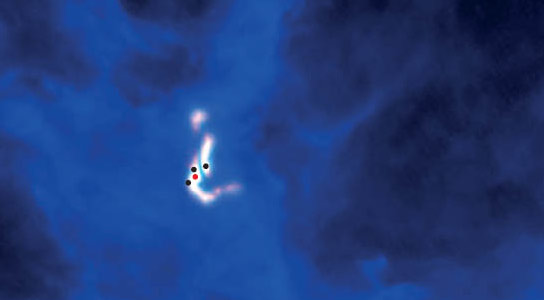
Astronomers report finding a nearby stellar nursery where quadruplets are being born. Credit: Nature; Pineda
Astronomers have discovered a nearby stellar nursery where quadruplets are being born.
More than half of all stars are in multiple systems: binary stars, or even triplets or quadruplets, that orbit one another. No one is quite sure how or why they form, but the effects can be significant, for example influencing the character of their planets. Our Sun is uncommon in having no companion star, perhaps suggesting that its configuration of planets is equally uncommon.
There are two principal ideas about how multiple stars form: fragmentation in the early stages of birth, or the gravitational capture of a nearby star later on. Computer simulations of star formation find that both are reasonable possibilities, and so astronomers have been trying to make observations to refine the models and the conclusions. Writing in this week’s journal Nature, Alyssa Goodman, and her collaborators report finding a nearby stellar nursery where quadruplets are being born. The region is in the star forming molecular cloud in the direction of the constellation of Perseus, about 825 light-years away. Scientists have known for decades about a protostar in this area, a dense core of material that is developing into a small star about one-tenth of a solar mass in size.
Using radio wavelength observations of dense molecular gas, ammonia in particular, the team discovered that around this protostar are several filamentary gas structures in which they detected three other condensations. The other three embryos are two to three times more massive than the main protostar, and models suggest they will become stars soon – in roughly forty thousand years. The longest dimension of the complex is only about ten thousand astronomical units (one AU is the average distance of the Earth from the Sun), and so these objects are close enough together for gravity to be the major influence in their development; velocity measurements confirm that the objects are physically associated.
It is possible – even likely – that during the stars’ development, their orbital motions will prompt the ejection of one or two members from the system, but for now it appears that at least one binary pair will survive for longer times. Other stellar systems need to be examined in order to see how widespread these young multiplets really are, but the new results support models in which multiple stars form very early in the stellar womb.
Reference: “The formation of a quadruple star system with wide separation” by Jaime E. Pineda, Stella S. R. Offner, Richard J. Parker, Héctor G. Arce, Alyssa A. Goodman, Paola Caselli, Gary A. Fuller, Tyler L. Bourke and Stuartt A. Corder, 11 February 2015, Nature.
DOI: 10.1038/nature14166




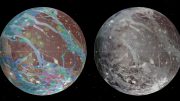
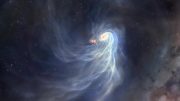
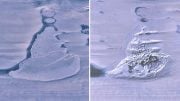
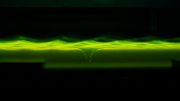
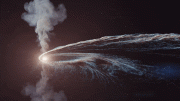
Be the first to comment on "The Formation of a Quadruple Star System"